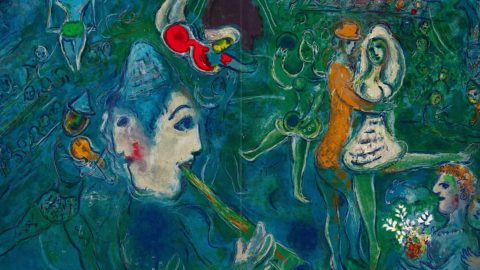Marc Chagall has developed a unique visual language. Mixing Fauvism, Symbolism and Cubism, he created a vivid dream world populated by wizards, mermaids and beautiful girls. His bold repertoire of fantastical symbols and vibrant colors has gained worldwide recognition, largely through the proliferation of his vibrant prints. Sotheby's auction.
Chagall initially experimented with printmaking as a young artist, creating a series of intaglio works to illustrate his autobiography. However he was not fully enthralled by the art form until the 50s, at which point Atelier Mourlot director Fernand Mourlot and accomplished lithographer Charles Sorlier introduced him to color lithography. Sorlier, who assisted the painters-engravers Pablo Picasso, Henri Matisse and Fernand Léger, only met Chagall when the famous artist was 63 years old. Although already established in his career, Chagall gladly sought the advice of the young engraver. The two became great friends and the mature student quickly became the master.
A methodical perfectionist, Chagall approached each lithograph by drawing his composition first in black on stone or zinc. He would then print several proofs, to which he added pops of color in pastel or wash. If satisfied, Chagall would then proceed to color tests, often employing Sorlier to make small adjustments by hand until he was completely satisfied with each shade. This was a painstaking process, as the individual lithographs in Chagall's largest print portfolios contain up to 25 unique colours.
Chagall's first major color portfolio was the romantic Daphnis et Chloé, published in 1961. The series of 42 kaleidoscopic lithographs tells the Arcadian love story of the Greek poet Longus. Chagall worked on the prints for four years, using some 1.000 zinc plates, before allowing famed publisher Tériade to release the set. His bright colors bring to life the ancient fairy tale, as seen in plate 39, Temple and History of Bacchus (M. 346; C. Bks. 46), in which the artist's golden and rosy hues evoke the sumptuousness of the sanctuary of the god (Lot 5).
His next great color masterpiece, Le Cirque (M. 490-527; C. Bks. 68) was published in 1967. Another work of love, the portfolio of 38 lithographs revisits the artist's favorite theme: the circus. As a boy in Vitebsk, Chagall looked forward to seeing acrobats and minstrels perform at the local village fairs. In Paris, he was overjoyed to finally be able to attend the Cirque d'Hiver, where he was to be found sketching equestrian and unicyclist sketches at night. Years later, he revisited his Cirque gouaches and decided to reinterpret them as a series of animated lithographs, accompanied by a text (Lots 21-58). For this project, he developed a palette of dark blues and cheerful yellows that capture the dramatic lights and exuberant atmosphere of the circus ring.
While working on these major projects, Chagall collaborated simultaneously with Charles Sorlier on several "secondary works," which are now some of the artist's most sought-after editions. Recognizing Sorlier's talent as a colourist, Chagall gave him permission to create lithographs after his unique works, from paintings to stained glass. Sorlier's most sought-after set after Chagall is the glorious Douze maquettes de vitraux pour Jérusalem, or Twelve Maquettes of Stained Glass for Jerusalem (M. CS. 12-23; C. Bks. 57). Inspired by the sublime stained glass windows created by Chagall for the synagogue of the Haddasah Medical Center, the plates depict Jacob's blessings for his twelve sons and Moses' blessing for the twelve tribes. The complete series captures Chagall's style for religious storytelling and expertly translates the diaphanous glow of his windows (Lot 8).
Source Sotheby's





